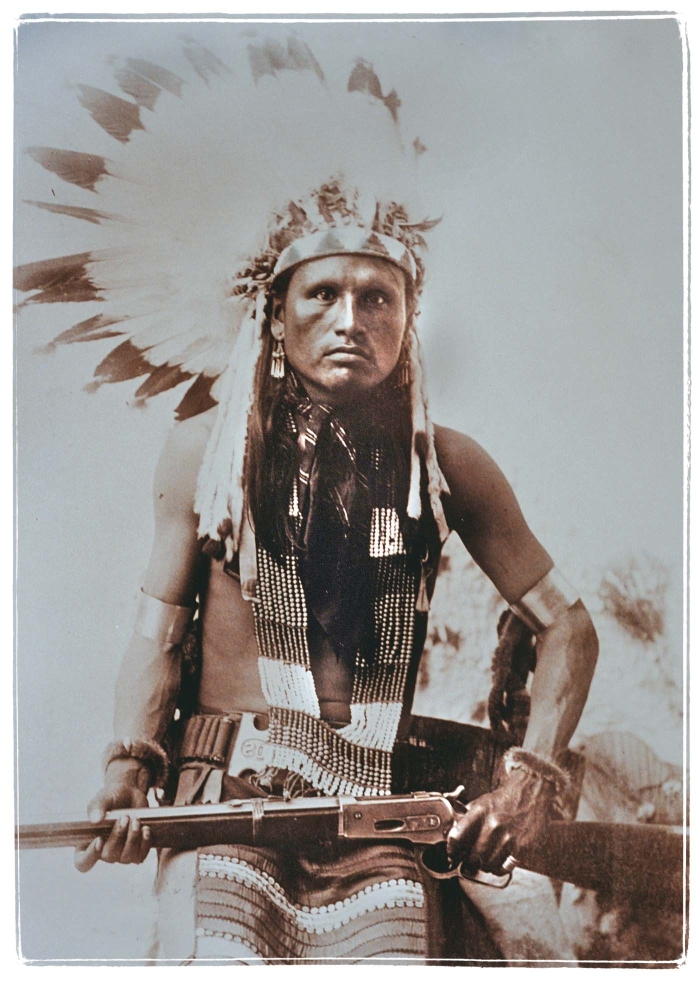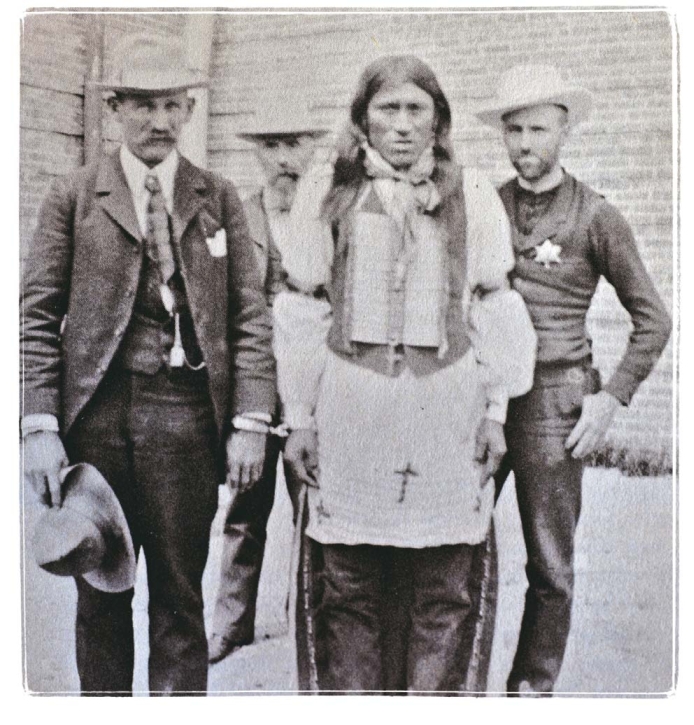Post by Dietmar on Jul 6, 2010 10:57:33 GMT -5
When I saw the portrait of Spotted Hawk posted by Grahame in another thread, I was curious about this man. I started to look around a bit and found this newsletter article by Renee Samson Flood, which is available in the net. Soaring Eagle is an organization to help Cheyenne elders. More newsletters and an option to donate can be found here:
www.soaringeagle.org/
Can anyone confirm Spotted Hawk being the son of Chief Spotted Wolf?
www.soaringeagle.org/
Spotted Hawk’s Ordeal 1897–1901
BY RENEE SANSOM FLOOD
www.soaringeagle.org/about/messages/Winter_2009.pdf
Spotted Hawk, a U.S. Army Scout, holds an octagon barreled 45-70 buffalo gun. Ft. Keogh, Montana. PHOTO BY CHRISTIAN BARTHELMESS 1889
“Hohtaheaenoh,” the Spotted Hawk, was too young to fight with the Northern Cheyennes against Custer in 1876, but the 9 year-old and his mother watched the Bighorn Battle from a safe place across the river. After many struggles and several more years of fighting for their homelands, the Cheyennes settled on their present reservation in 1883, in what is now southeastern Montana. In return, the government promised the tribe regular food rations, homes and clothing, but government promises blew away like leaves in the wind. Every year, the Cheyennes died from starvation and disease. Without medical help, adequate food, shelter and forbidden to practice traditional customs, they lost hope and spiraled into discouragement and despair.
Hearing of their plight, Catholic missionaries moved to the reservation. One of the first priests was Father Aloysius Van der Velden, S.J., called by the Cheyennes, “The One Who Limps.” Spotted Hawk’s family welcomed the new Dutch priest and the Ursuline Sisters. By the summer of 1897, 30 year-old Hugh Spotted Hawk was regularly attending church services in the newly built mission chapel. Despite a drought, he was also busy preparing for the fall harvest. A quiet family man, Hugh worked as a plow foreman, a position that earned him a decent wage. A few months earlier, Hugh heard that a white sheepherder had been murdered by an Indian named David Stanley. The agent asked Spotted Hawk and others to capture and bring the man in to face prosecution. Hugh took time off from work to bring the culprit in to the agency jail and didn’t think much about it afterward.
On July 20th, Hugh, a former U.S. Army Scout under General Nelson A. Miles, was working in the hay fields when tribal policemen arrested and took him to the Agent, Capt. George W. H. Stouch. Spotted Hawk was stunned to find that his brother, Little Whirlwind, was also in jail. Although David Stanley had originally admitted he alone murdered the sheepherder, he had suddenly changed his story, implicating Spotted Hawk and Little Whirlwind as his accomplices. The brothers sent word to Fr. Van der Velden, who came at once to pray with them.
Meanwhile, the murder of the young white man was causing an uproar in the ranching communities. Casting suspicion on Indians was a familiar fear tactic aimed at driving them from their reservation. Ranchers circulated rumors that Cheyenne warriors were ready to attack and that 500 vigilantes stood ready for the “Indian uprising.” Sheriff John Gibb from Miles City, rode to the agency with 25 half drunk cowboys looking for blood. The agent refused their demand to hand over the prisoners, knowing that to do so would have created mob violence. Agent Stouch, anticipating trouble, had already called for Capt. Robert D. Read, and the Tenth Cavalry. The soldiers arrived in time to escort the sheriff and his neck tie party off the reservation. During the scare, Fr. Van der Velden further angered ranchmen by again visiting the jailed prisoners. Antagonism against the missionaries had been evident for 15 years, much of it aimed at the priest who vowed to educate Indians. Fr. Van der Velden’s life had been threatened, once with a gun to his stomach, but he was determined to stay, despite ill health. Just as rumors of war increased and the priest realized he could not help Spotted Hawk, Rev. Van der Velden came down with typhoid fever and was in a coma for two weeks. When he didn’t fully recover, Bishop Brondel recalled him. From his hospital bed, Father wrote to his brother in Holland telling him why he was leaving after 12 years with the tribe, “The whites were after my life; my death was resolved upon.” When Spotted Hawk heard that Father had left for good and that Agent Stouch had been transferred, he and his brother broke out of jail and walked back to the reservation. They just wanted to see their wives and children one last time.
The brief and joyous visit came to an end when the innocent men were recaptured. George Bird Grinnell, naturalist and close friend of Herbert Welsh and Theodore Roosevelt, soon to be elected President of the United States, had spent many years on the Northern Cheyenne Reservation. He knew Spotted Hawk and when he found out that his friend had been charged with First Degree Murder and was sentenced to hang, Grinnell took immediate action. After notifying his powerful friends in Washington and New York, funds poured in for Spotted Hawk and his brother’s defense.
Working against them were Montana Governor Robert B. Smith and Senator Thomas H. Carter, close friends of the presiding Judge Charles H. Loud. All three men were well known advocates for cattlemen. Judge Loud overturned a court ruling that would have given the Cheyennes a new trial while their families struggled to survive. Within a year, accused murderer David Stanley died of tuberculosis in jail but not before he admitted to authorities that he had lied about Spotted Hawk and Little Whirlwind. They were not guilty of murder. Despite his confession, the Cheyenne brothers remained in jail. Grinnell and his supporters hired the best lawyers and quietly backed by Teddy Roosevelt, Spotted Hawk was finally released. Little Whirlwind was to stay in jail for 4 years until 1901. By then, the government had removed ranchers from the borders of the reservation and they were finally forced to acknowledge the legality of permanent reservation lines. In fairness to the ranchers, legal boundaries should have been made long before cattlemen settled in the area. Ten years before, they already had 150,000 cattle and horses and 30,000 sheep grazing on reservation land. After their release from jail, the Cheyenne brothers returned to their homes. Before long, Spotted Hawk’s land was entirely cultivated. A reservation land survey found Hugh “a very active farmer,” with a large vegetable garden and many acres of wheat, oats, corn, potatoes, alfalfa and hay. He also raised cattle, horses and pigs. After his wife died, Hugh’s daughter moved into his log cabin to care for him until he passed away at the age of 62. If the agony of wrongful imprisonment and the fear of the hang man’s rope made him a bitter man, Hugh did not show it.
After he died, Spotted Hawk’s name was given to his nephew, Chief Clarence, “Bisco” Spotted Wolf. In 2009, Bisco in turn handed the name down to his relative, Joseph, a young scholar with a Master’s Degree from the University of Maryland. Spotted Hawk distinguished himself as a U. S. Army Scout but most important of all, he was a good father, a loving husband and a hard worker whose name will live forever in Northern Cheyenne history.
Sources:
Heritage Living Center Oral History Project: interview with James Medicine Bird, February 6, 1973.
The New York Times, “To Save Spotted Hawk’s Life, Steps Taken To Secure a Review of His Conviction for Murder,” November 26, 1897.
U. S. Government Survey of Northern Cheyenne Reservation living conditions, May 5, 1924
Report to Commissioner of Indian Affairs, Washington, DC., from Northern Cheyenne Agent George W.H. Stouch, Captain, 3rd Infantry, June 5, 1897
The Northern Cheyenne Indian Reservation, 1877- 1900, Orlan J. Svingen
A Review of the Spotted Hawk Case by the Indian Rights Association, 1898
Spotted Hawk’s Death Warrant, Records of the Clerk of Court, District Court, Seventh Judicial District, Miles City, Custer County, Montana
State v. Little Whirlwind 22 Mont. 425 (1899); State v. Spotted Hawk 22 Mont. 1899
Little Whirlwind, one of Lt. Ed Casey’s famous Cheyenne Scouts, stands tall at the moment of his arrest. Sheriff John Gibb in background. PHOTO BY CHRISTIAN BARTHELMESS 1897
Can anyone confirm Spotted Hawk being the son of Chief Spotted Wolf?




